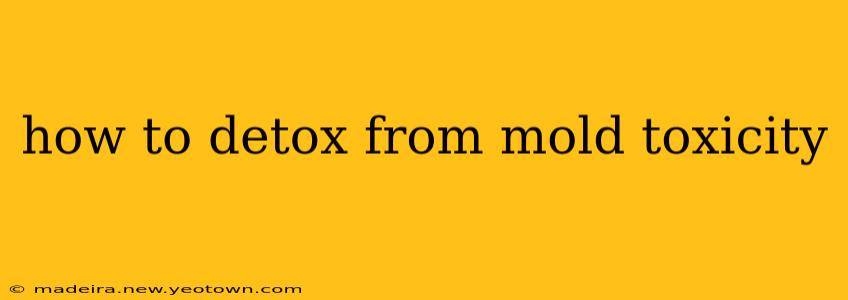Mold toxicity, or mycotoxicosis, is a serious health issue affecting millions. It's a sneaky adversary, often leaving sufferers feeling lost and frustrated as they grapple with debilitating symptoms. This isn't just about a stuffy nose; we're talking fatigue, brain fog, headaches, respiratory problems, and even more severe conditions. This comprehensive guide will walk you through the process of detoxing from mold toxicity, focusing on a holistic approach that prioritizes both removal of the source and support for your body's natural healing mechanisms. Remember, this is a journey, not a sprint, and professional guidance is crucial.
What are the Symptoms of Mold Toxicity?
Many experience symptoms that mimic other illnesses, making diagnosis challenging. Recognizing the signs is the first crucial step. Common symptoms include:
- Persistent fatigue: An overwhelming tiredness that doesn't improve with rest.
- Brain fog and cognitive impairment: Difficulty concentrating, memory problems, and mental confusion.
- Headaches: Frequent and intense headaches, often migraines.
- Respiratory issues: Coughing, wheezing, shortness of breath, and sinus infections.
- Skin problems: Rashes, itching, eczema, and other dermatological issues.
- Gastrointestinal distress: Nausea, vomiting, diarrhea, and abdominal pain.
- Joint and muscle pain: Aches and pains that are widespread and persistent.
If you're experiencing multiple of these symptoms, particularly after exposure to a damp or moldy environment, it's vital to consult a doctor who specializes in environmental illness.
How Can I Detox from Mold?
Detoxification from mold isn't a quick fix; it's a multifaceted process involving several key steps:
1. Identifying and Removing the Source
This is arguably the most important step. You can't effectively detox if you're still being exposed to the mold. This requires a thorough investigation of your home or workplace, possibly involving a professional mold inspection and remediation specialist. Addressing the source is paramount before you even think about other detoxification methods.
2. Improving Air Quality
Once the source is removed (or at least significantly mitigated), improving your indoor air quality is crucial. This involves:
- Air purifiers with HEPA filters: These filters trap mold spores and other allergens.
- Regular cleaning and dusting: This removes mold spores that may have settled.
- Dehumidifiers: Reducing humidity levels can inhibit mold growth.
3. Supporting Your Body's Natural Detoxification Systems
This involves providing your body with the nutrients and support it needs to process and eliminate toxins. Key strategies include:
- Hydration: Drink plenty of pure water throughout the day.
- Nutrient-rich diet: Focus on whole, unprocessed foods, including plenty of fruits, vegetables, and antioxidants.
- Supplements: Some supplements, such as glutathione, chlorella, and binders like activated charcoal, may support detoxification (always consult your doctor before starting any new supplements).
4. Medical Support and Monitoring
It's crucial to consult with a physician knowledgeable about mold toxicity. They can run tests, diagnose the extent of the problem, and recommend appropriate treatment strategies, which may include medication to manage symptoms. Regular check-ups are essential to monitor your progress and adjust the treatment plan as needed.
How Long Does it Take to Detox from Mold?
The detoxification process varies greatly depending on the severity of exposure and individual factors. It can take weeks, months, or even longer to feel significant improvement. Patience and persistence are key.
What are the Best Detoxification Methods for Mold Toxicity?
There's no single "best" method, and approaches are best tailored to the individual's needs. The focus should always be on addressing the source of exposure, improving air quality, and supporting the body's natural detoxification pathways. This holistic approach provides the most effective results.
Can I Detox from Mold Naturally?
Many natural approaches support detoxification, but they should be part of a comprehensive plan that also tackles the source and improves air quality. A healthy diet, adequate hydration, and stress reduction techniques all play important roles. However, severe cases often require medical intervention.
What are Some Home Remedies for Mold Toxicity?
Home remedies can offer supportive measures, such as consuming antioxidant-rich foods and staying well-hydrated. But these shouldn't replace professional medical advice and remediation of the mold source.
This journey toward wellness requires patience, consistency, and a multi-pronged approach. Prioritizing the removal of the mold source, improving air quality, and supporting your body’s natural detoxification systems are the cornerstones of effective recovery. Remember, always consult with healthcare professionals experienced in environmental illness for personalized guidance. They'll be your trusted allies in navigating the path to a healthier, mold-free life.

